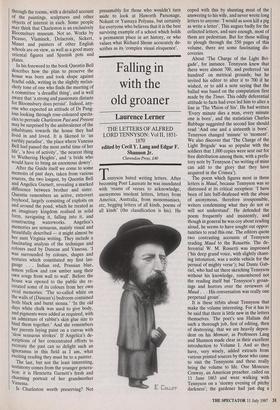The blooms are not yet buried
Frances Partridge
CHARLESTON PAST AND PRESENT by Quentin Bell, Angelica Garnett, Henrietta Garnett and Richard Shone
The Hoganh Press, £5.95
Imust declare an interest in this attrac- tive and well-planned little book, since all its four authors are among my close friends, and the house itself has been the scene of many of my nostalgic memories dating back to the late Twenties. Primarily intended as a guide for visitors to the house which is now open to the public — it also tactfully provides plenty to read in the train back from Lewes, just as (after a night at the opera) the latter pages of the programme act as fodder for a mind stimulated by musical experience. Unlike the enormous, glossy, slippery catalogues as heavy as lead sold at many exhibitions of painting, Charleston Past and Present is a light pocket-sized paperback with a pretty cover by Angelica Garnett. The only dis- advantage of this lack of gloss is that some of the many illustrations are in slightly muted colour, a fact especially noticeable in the pictures of the garden. Charleston garden always seemed to be full of un- usually large and brightly coloured flowers; perhaps they benefited, and still do, from rich soil and the protection of a high old .wall. It has now been beautifully restored under the supervision of Sir Peter Shepheard, with due attention to maintain- ing past favourites such as red-hot pokers, Dianthus Mrs Sinkins, santolina and astrantia (NB misspelled). Visitors are shown the way through house and garden by several clear plans and the expert guidance of Richard Shone, who tells us in his historical note that after the second world war the garden was looked after by 'young Mr Stevens' (so-called because although he was a pensioner his mother was nearly a hundred) to such effect that Vanessa complained that 'one could hardly walk down the paths for the plants that get in the way.'
Entering the house we discover why there are china number-plates on the bed- room doors, in which room Maynard Keynes wrote The Economic Consequ- ences of the Peace, and in which Angelica was told that Duncan Grant was her father. Such items are part of a scholarly journey through the rooms, with a detailed account of the paintings, sculptures and other objects of interest in each. Some people may think that Charleston is an exclusively Bloomsbury museum. Not so. Works by Picasso, Vlaminck, Delacroix, Sickert, Manet and painters of other English schools are on view, as well as a good many oriental figures and Spanish pots and plates.
In his foreword to the book Quentin Bell describes how the plan to preserve the house was born and took shape against fearful odds, writing in the slightly, melan- choly tone of one who finds the meeting of a conunittee 'a dreadful thing', and is well aware that 'a strong and passionate distaste for Bloomsbury does persist'. Indeed, any- one who expected an attitude of Dr Pang- loss looking through rose-coloured specta- cles to pervade Charleston Past and Present may be surprised by the ambivalence of the inhabitants towards the house they had lived in and loved. It is likened to 'an earthly paradise', 'the place where Vanessa Bell had passed the most awful time of her life', 'a hive of activity', 'the nearest thing to Wuthering Heights', and 'a bride who would have to bring an enormous dowry'.
After the Guide itself we come to some memoirs of past days, taken from various sources, the two longest, by Quentin Bell and Angelica Garnett, revealing a marked difference between brother and sister, Quentin remembers an active, extrovert boyhood, largely consisting of exploits on and around the pond, which he treated as an imaginary kingdom realised in solid form, navigating it, falling into it, and constructing waterworks. Angelica's memories are sensuous, mainly visual and beautifully described — it might almost be her aunt Virginia writing. They include a fascinating analysis of the technique and colours used by Duncan and Vanessa. 'I was surrounded by colours, shapes and textures which constituted my first lan- guage . . Indian red, Prussian blue, lemon yellow and raw umber sang their own songs from wall to wall'. Before the house was opened to the public she re- created some of its colours from her own vivid memories: 'The so-called white on the walls of (Duncan's) bedroom contained both black and burnt sienna.' In the old days white chalk was used to give body, and pigments were added as required, with an admixture of rabbit's skin glue size to bind them together.' And she remembers her parents laying paint on a canvas with Slow sensuous strokes'. If Angelica's de- scnptions of her concentrated efforts to recreate the past can so delight such an ignoramus in this field as I am, what exciting reading they must be to a painter.
The last, but not the least interesting, testimony comes from the younger genera- tion: it is Henrietta Gametes fresh and charming portrait of her grandmother Vanessa.
Is Charleston worth preserving? Not presumably for those who wouldn't turn aside to look at Haworth Parsonage, Nohant or Yasnaya Polyana, but certainly for everyone who believes that it is the best surviving example of a school which holds a permanent place in art history, or who values what Richard Shone accurately de- scribes as its 'complex visual eloquence'.



















































 Previous page
Previous page